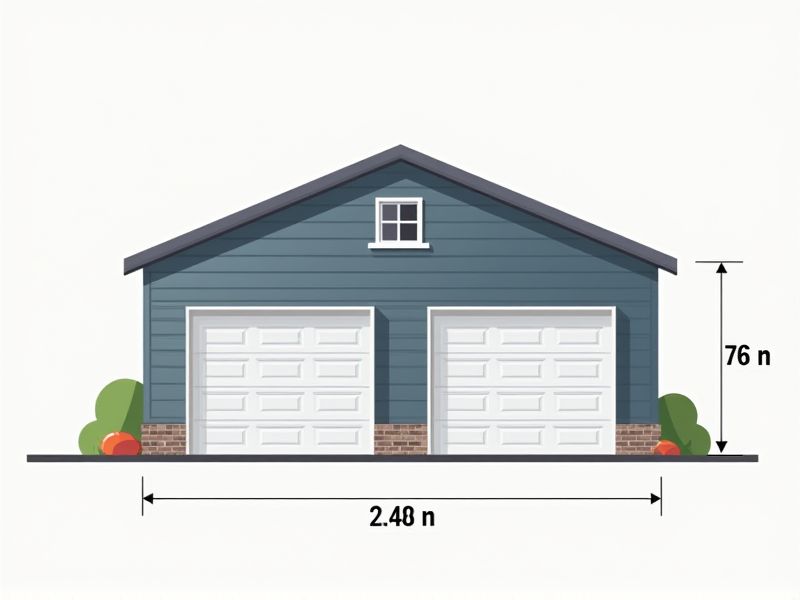
When planning for a 2-car garage, understanding the standard dimensions ensures you have sufficient space for vehicles and storage. The typical size for a 2-car garage is about 20 feet wide by 20 feet deep, but many homeowners opt for slightly larger dimensions such as 24 feet by 24 feet to allow for extra storage or easier car access. A standard garage door for two cars is usually 16 feet wide, which provides enough room for most vehicles to enter and exit comfortably. Taking the time to consider your specific vehicle sizes and any desired workspace can help you determine if a larger or custom-sized garage would better meet your needs.
Width
A standard two-car garage typically measures about 20 feet in width, which provides ample space for parking two vehicles side by side. A minimum depth of 24 feet is generally recommended for sufficient maneuverability and storage options. Your garage's width may need to be increased if you have larger vehicles, such as SUVs or trucks, or if you want extra storage for bicycles or tools. Ensuring that the width accommodates your needs will optimize functionality and convenience, enhancing the usability of your garage space.
Depth
The standard depth of a 2-car garage typically ranges from 20 to 24 feet, allowing for adequate space to accommodate larger vehicles, storage, and the possibility of a workbench. A depth of 22 feet is often recommended for comfortable maneuverability, ensuring that doors can open fully without obstruction. Furthermore, this clearance helps maintain a spacious feel, crucial for efficient access to tools and equipment. Your choice of depth can significantly impact the functionality of the garage, making it essential to consider how you intend to use the space.
Height
A standard 2-car garage typically has a minimum height of 7 to 8 feet to accommodate most vehicles, including SUVs and trucks. This height allows for ample vertical clearance, ensuring that your vehicle can enter and exit the garage without risk of damage. In some designs, a garage height of up to 10 feet may be preferred for added space, especially if you're considering overhead storage solutions. When planning your garage, remember to consider the height of any garage door mechanisms, as they must also fit within this vertical space.
Door Dimensions
A standard 2-car garage typically features door dimensions of 16 feet wide by 7 feet high, accommodating most vehicles comfortably. This size allows for easy access and movement, reducing the risk of door dings and scratches. The height is designed to fit larger vehicles, including trucks and SUVs, ensuring versatility. If you are considering garage door options, it's essential to check local building codes for any specific regulations related to dimensions and installation.
Ceiling Clearance
A standard 2-car garage typically features a ceiling clearance of at least 8 feet, allowing ample space for vehicle entry and upper storage. In some designs, especially those accommodating larger SUVs or trucks, a height of 10 to 12 feet may be preferred to ensure easy maneuverability. This ceiling height helps prevent potential issues with overhead storage racks, which can be critical for maximizing your garage's functionality. When planning your garage layout, you may want to consider these dimensions to optimize both accessibility and storage capacity.
Vehicle Size Accommodation
A standard 2-car garage typically measures 20 feet by 20 feet, providing ample space for most vehicles, including sedans, SUVs, and even some larger trucks. To ensure optimal vehicle accommodation, the garage should have a minimum height of 7 to 8 feet, allowing for comfortable clearance. This design facilitates the storage of two average-sized cars side by side, each having approximately 10 feet of width and 18 feet of length to maneuver. For enhanced usability, consider including an extra foot or two in both dimensions for storage or additional space around the vehicles.
Storage Space
A standard 2-car garage typically measures around 400 square feet, providing ample storage space for vehicles, tools, and recreational items. With vertical storage solutions, you can maximize the area by incorporating shelves, cabinets, and pegboards, which allow for organized storage of up to 500 pounds of equipment. Implementing wall-mounted racks can create up to 4 feet of additional floor space, facilitating better accessibility to your belongings. For optimal organization, consider utilizing bins and labeled containers, ensuring everything has a designated spot while keeping your garage clutter-free.
Walkway Space
A standard 2-car garage typically measures 20 feet by 20 feet, providing ample space for two vehicles alongside additional storage. When designing a functional walkway space, a minimum width of 3 feet is recommended to ensure safe and convenient passage. Ideal walkway materials include concrete or pavers, which can withstand weight and are easy to maintain. Incorporating landscaping elements, such as shrubs or decorative stones along the walkway, can enhance the aesthetic appeal while ensuring the path remains clear and accessible.
Ventilation Requirements
A standard 2-car garage typically requires adequate ventilation to prevent moisture buildup and ensure air circulation, which is crucial in maintaining garage health and preventing mold growth. The International Residential Code (IRC) recommends at least 1 square foot of ventilation opening for every 300 square feet of floor area; for a 2-car garage, this equates to approximately 6.67 square feet of ventilation. This can be achieved through a combination of passive vents, windows, and mechanical ventilation systems that help regulate temperature and humidity. Incorporating ridge vents or soffit vents can also significantly enhance airflow, creating a well-ventilated environment suitable for vehicle storage and workspace.
Lighting Provisions
A standard 2-car garage typically requires a minimum of 400 to 800 lumens for adequate lighting, ensuring a well-lit environment for vehicle storage and maintenance tasks. Ideally, overhead fixtures such as LED ceiling lights with a color temperature of 4000K to 5000K provide optimal brightness without harshness. Incorporating task lighting, such as fluorescent or LED strip lights, above workbenches enhances functionality for DIY projects. Consider installing motion-sensor lights for added convenience and energy efficiency, ensuring your garage remains illuminated when you need it most.
